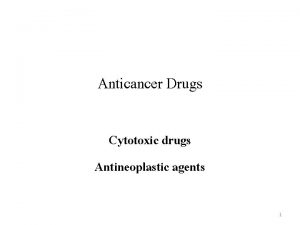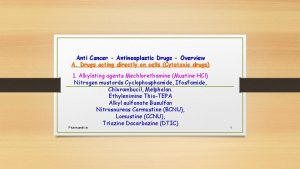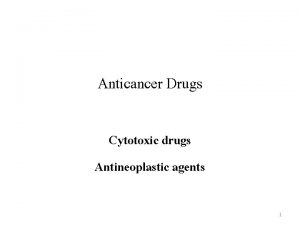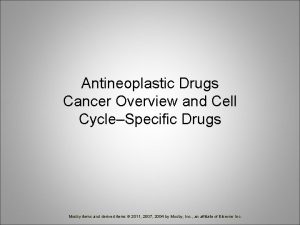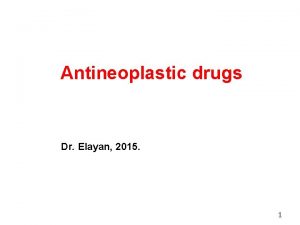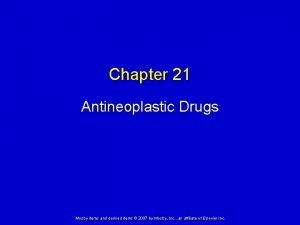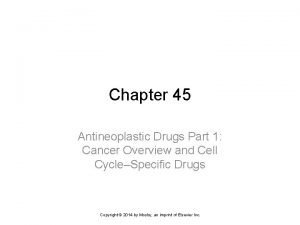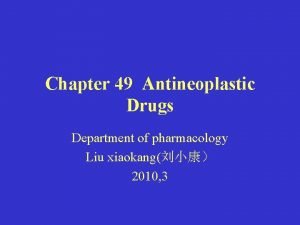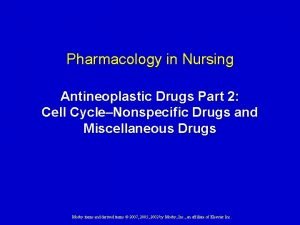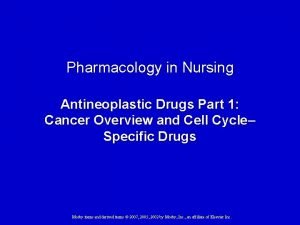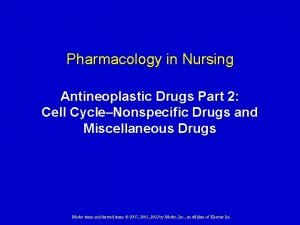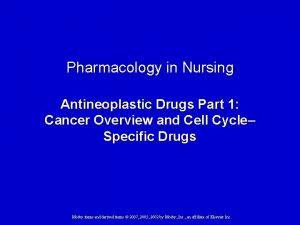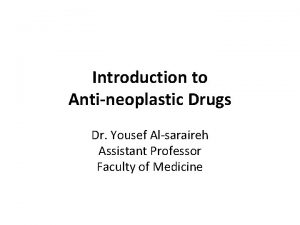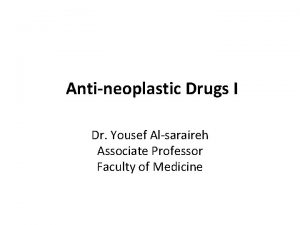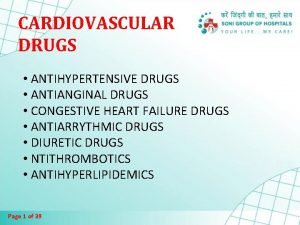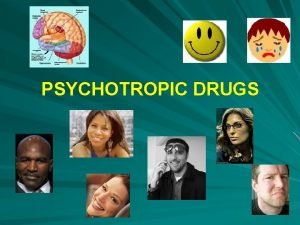Chapter 14 Antineoplastic Drugs Copyright 2015 Cengage Learning






















- Slides: 22

Chapter 14 Antineoplastic Drugs Copyright © 2015 Cengage Learning®

Introduction • A healthy body needs cells to reproduce and grow in an orderly, regulated manner – Sometimes, conditions are altered in the body that trigger abnormal changes in the way the cells reproduce and grow • Can cause cell growth to become uncontrolled, leading to overproduction or impaired cellular development Copyright © 2015 Cengage Learning® 2

Introduction (cont’d. ) • Unregulated growth can lead to abnormal cells, tissue, and tumor development – Tumors can be classified as either benign (non-cancerous) or malignant (cancerous) • Antineoplastics (“against new tissue formation”) – Agents that counteract the development, growth, or spread of malignant cells – Can treat various types of cancers Copyright © 2015 Cengage Learning® 3

Introduction (cont’d. ) • What is chemotherapy? – Drugs and drug combinations used for palliative effects or for long-term or complete remissions in early treatment of cancer • Antineoplastic drugs are cytotoxic (destructive to cells), and especially to cells that are proliferating (reproducing rapidly) • Many antineoplastic agents also possess immunosuppressive properties Copyright © 2015 Cengage Learning® 4

Introduction (cont’d. ) • Antineoplastic agent groups – Antimetabolites – Alkylating agents – Mitotic inhibitors – Antitumor antibiotics – Hormones and hormone modifiers – Biological therapies Copyright © 2015 Cengage Learning® 5

Introduction (cont’d. ) – Targeted cancer therapies – Vaccines – Radioactive isotopes Copyright © 2015 Cengage Learning® 6

Introduction (cont’d. ) • The following slides discuss various antineoplastic drugs – Refer to the chapter for specific side effects and contraindications Copyright © 2015 Cengage Learning® 7

Antimetabolites • Work by interfering with DNA synthesis, repair, and cellular replication – Used in the treatment of various malignancies, especially those involving rapidly proliferating neoplasms • Examples: methotrexate and fluorouracil Copyright © 2015 Cengage Learning® 8

Alkylating Agents • Can treat a wide range of cancers – Prevent growth by damaging DNA needed for reproduction • Examples: cisplatin and cyclophosphamide Copyright © 2015 Cengage Learning® 9

Mitotic Inhibitors • Mitosis is the process of cell division and reproduction – Mitotic inhibitors are often plant alkaloids and other compounds derived from natural products that block mitosis • Can treat many different types of cancer • Plant alkaloid examples: vinblastine, vincristine, and paclitaxel Copyright © 2015 Cengage Learning® 10

Antitumor Antibiotics • Can treat a wide variety of malignancies – Examples: doxorubicin, daunorubicin, bleomycin, daunorubicin, mitomycin, and others • Frequently used in combination with other drugs Copyright © 2015 Cengage Learning® 11

Hormones and Hormone Modifiers • Hormones – Corticosteroids: used primarily for their suppressant effect on lymphocytes • Hormone modifiers – Antiestrogen: hormonal therapy for metastatic estrogen receptor–positive breast cancer and palliative treatment – Antiandrogen: hormonal therapy in the treatment of endometriosis and metastatic prostate cancer Copyright © 2015 Cengage Learning® 12

Biological Therapies • Designed to repair, stimulate, or enhance cancer patients' natural immune systems – More effectively recognize and attack cancer cells • Active or direct and passive or indirect • Interferon alfa – Most widely used in cancer treatments – Complex combination of many proteins that boost immune system response Copyright © 2015 Cengage Learning® 13

Biological Therapies (cont’d. ) • Colony-stimulating factors (CSFs) – Encourage bone marrow stem cells to divide and develop into red and white blood cells, and platelets • Monoclonal antibodies (MABs) – Exogenous (outside of body) antibodies genetically engineered in the laboratory – Designed to target only cancer cells, thereby sparing normal tissues Copyright © 2015 Cengage Learning® 14

Targeted Therapies • Block the growth and spread of cancer – Interfere with specific molecules involved in tumor growth and progression • Signal transduction inhibitors – Block specific enzymes and growth factor receptors that signal cancer cell proliferation Copyright © 2015 Cengage Learning® 15

Vaccines • Medicines that boost the immune system’s natural ability to protect the body against “foreign invaders” – Mainly infectious agents that may cause disease • Broad types of cancer vaccines – Preventive (or prophylactic) – Treatment (or therapeutic) Copyright © 2015 Cengage Learning® 16

Radioactive Isotopes • Used in the treatment of certain types of cancer – Sometimes the radioactive material is injected into the affected site or implanted in the body in the form of capsules, needles, or seeds – Health care practitioners caring for patients receiving radioactive isotopes must observe special precautions to prevent unnecessary radiation exposure Copyright © 2015 Cengage Learning® 17

Cautions and Responsibilities for Antineoplastic Drugs • Medications should be given on time and exactly as prescribed • Intravenous sites must be checked with great care • Intravenous fluids containing antineoplastic agents should not be allowed to get on the skin or into the eyes of the patient or administrator Copyright © 2015 Cengage Learning® 18

Cautions and Responsibilities for Antineoplastic Drugs (cont’d. ) • Antiemetics should be immediately available and administered as prescribed • Careful and frequent oral hygiene is essential • Soft foods and cool liquids should be available to the patient as required • Accurate intake and output is important for adequate assessment of hydration Copyright © 2015 Cengage Learning® 19

Cautions and Responsibilities for Antineoplastic Drugs (cont’d. ) • Careful observation and reporting of symptoms and side effects is essential • Aseptic technique is necessary to minimize the chance of infection • Careful assessment of vital signs is important • The health care practitioner and family must be informed answer patient’s questions honestly Copyright © 2015 Cengage Learning® 20

Cautions and Responsibilities for Antineoplastic Drugs (cont’d. ) • Careful attention to detail, astute observations, appropriate interventions, and compassion are an integral part of care during chemotherapy • The health care practitioner should: – Reassure the patient that someone will be available to help at all times – Identify all resources available for both the patient and their family Copyright © 2015 Cengage Learning® 21

Cytotoxic Drug Dangers to Health Care Personnel • Most cytotoxic drugs are toxic substances known to be carcinogenic, mutagenic, or teratogenic – Anyone who prepares, administers, or cares for patients receiving cytotoxic drugs should be aware of the dangers involved • Refer to the chapter for specific recommendations Copyright © 2015 Cengage Learning® 22
 Cengage chapter 7
Cengage chapter 7 Chapter 13 medical math assignment sheet
Chapter 13 medical math assignment sheet Chapter 7:10 respiratory system
Chapter 7:10 respiratory system Copyright 2015 all rights reserved
Copyright 2015 all rights reserved Copyright © 2015 all rights reserved
Copyright © 2015 all rights reserved 2009 delmar cengage learning
2009 delmar cengage learning Medical terminology chapter 5 learning exercises answers
Medical terminology chapter 5 learning exercises answers Cengage learning heart diagram
Cengage learning heart diagram South-western cengage learning
South-western cengage learning 2009 delmar cengage learning
2009 delmar cengage learning Cengage learning heart diagram
Cengage learning heart diagram Challenge word building medical terminology
Challenge word building medical terminology Cengage learning australia
Cengage learning australia Measuring and recording apical pulse
Measuring and recording apical pulse Whille
Whille Cengage learning
Cengage learning Wadsworth cengage learning
Wadsworth cengage learning Cengage learning
Cengage learning Cengage learning plant cell
Cengage learning plant cell Cengage learning
Cengage learning Cengage learning
Cengage learning Brooks cole cengage learning
Brooks cole cengage learning 2014 cengage learning accounting answers
2014 cengage learning accounting answers























